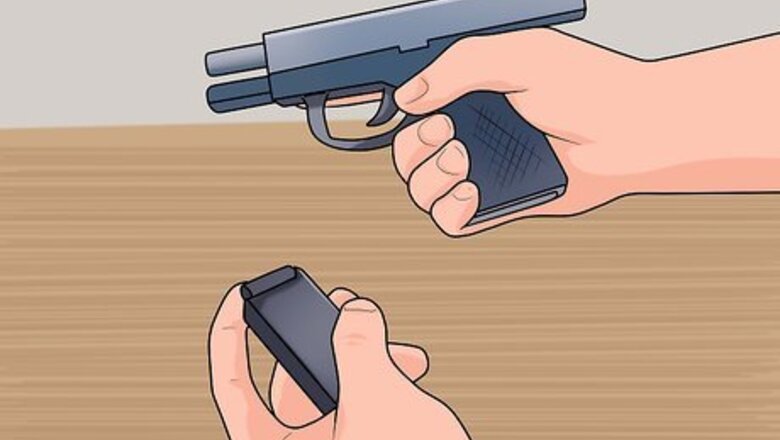
views
Providing Basic First Aid
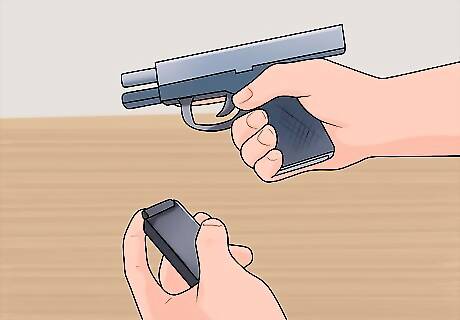
Establish that you are in a safe position. If the victim was shot unintentionally (such as while hunting), make sure that the firearm is pointed away from others, cleared of ammo, safe, and secured. If the victim was shot in a crime, verify that the shooter is no longer on the scene and that both you and the victim are safe. Wear personal protective equipment, such as latex gloves, if available. If there’s an active shooter, run and hide. Only help with casualties when it’s safe to do so.

Call for help. Dial 911 for emergency medical assistance and follow the dispatcher's instructions. The dispatcher can help you stop the bleeding and walk through the rest of the steps if no one else is available to help. Ideally, the injured person should be inside an ambulance within 10 minutes of getting shot.

Avoid moving the victim if they were shot in the neck or back. This can damage the spinal cord and cause permanent paralysis. In addition, avoid elevating their legs—this can cause abdominal and chest wounds to bleed quickly and make it harder for the person to breathe.

Act quickly. Time is your enemy in treating the victim—the average time for someone to bleed out after experiencing trauma from an injury is only 3 to 5 minutes. Try to keep your movements swift without making the person feel more upset or panicked.

Apply direct pressure to control bleeding. Identify the source of the bleeding and remove any clothing blocking the area. If there’s no trauma first aid kit available, take a clean cloth and press directly against the wound using the palm of your hand, an elbow, or a knee—whatever it takes to stop the hemorrhage. Add new bandages over the old; do not remove bandages when they become soaked. If there is a first aid kit available, pack the wound with bleeding control gauze, any gauze, or a clean cloth. Apply steady direct pressure with the palm of your hand.

Apply dressing to a leg or arm wound. If a tourniquet is not available or does not stop the bleeding, pack the wound with a clean cloth or gauze. Apply pressure with both hands and use a cloth, shirt, or whatever is at hand to press into the wound. There is little you can do for torso wounds outside of a hospital—just keep steady pressure and direct emergency responders to the victim when they arrive.

Be prepared to treat the victim for shock. Gunshot wounds can lead to shock, a condition caused by trauma or blood loss. Expect that a gunshot victim will show signs of shock and treat them accordingly by making sure the victim's body temperature remains consistent — cover the person so that he does not get cold. Loosen tight clothing and drape him in a blanket or coat. Typically you would want to elevate the legs of someone experiencing shock, but refrain from doing so if they might have a spinal injury or a wound in the torso. Don’t let the person eat or drink anything—not even water.

Give reassurance. Tell the person that she's okay and that you're helping. Reassurance is important. Ask the person to talk to you. Keep the person warm. If possible, ask the person about any medications she is taking, any medical conditions (i.e. diabetes, hypertension), and any drug allergies she may have. This is important information and may distract her from her wound.
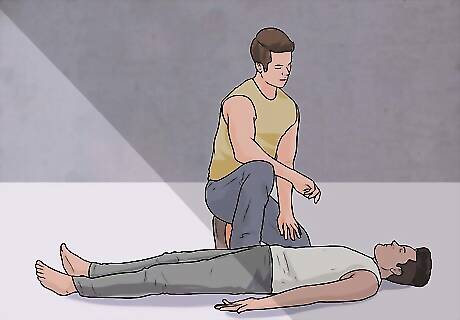
Stay with the person. Continue to reassure and keep the victim warm. Wait for the authorities. If the blood congeals around the bullet wound, do not remove blood mats on wound, as this may be limiting blood loss.
Assessing the Victim's Status

Remember the A, B, C, D, E's. For advanced treatment it is important to consider the status of the person. A, B, C, D, E is an easy way to remember the important factors you should consider. Assess these five critical factors to see what sort of assistance the victim requires.

Check the airway. If the person is talking, his airway is probably clear. If the person is unconscious, check to make sure that his airway is not obstructed. If it is and there is no spine injury, tilt their head and lift their chin. Apply gentle pressure to the forehead with the palm of one hand. Placing the other hand under the chin and use it to tilt the head back.
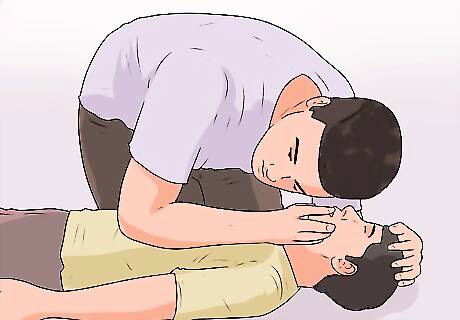
Monitor breathing. Is the victim taking regular breaths? Can you see her chest rising and falling? If the victim is not breathing, start CPR immediately. If the person doesn’t have a pulse, CPR would not be effective.
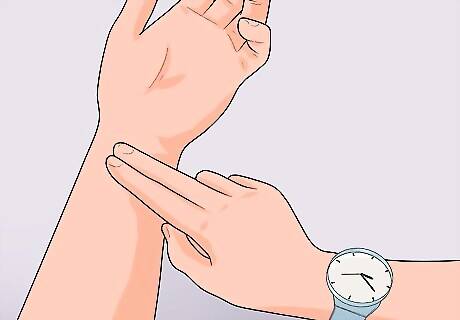
Check circulation. Apply pressure to any bleeding, then check the victim's pulse at the wrist or throat. Does the victim have a discernible pulse? If not, begin CPR. Control any major bleeding.
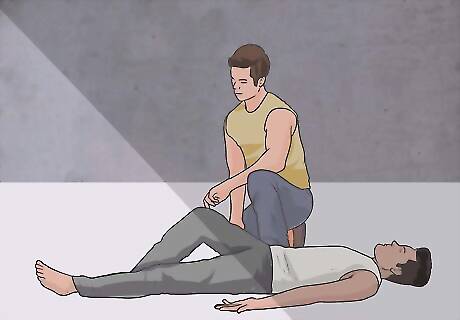
Look for a disability. Disability refers to damage to the spinal cord or neck. Check to see if the victim can move his hands and feet. If not, there may be an injury to the spinal cord. Look for compound or obvious fractures, dislocations, or anything that looks out of place or unnatural. If the victim shows signs of disability, you should refrain from moving them.

Check for exposure. Check the victim as thoroughly as possible for other wounds that you may be unaware of. Pay special attention to the armpit, buttocks or other difficult-to-see areas. Avoid completely undressing the victim before emergency help arrives as this may increase heat loss and shock.
Treating a Wound in the Arms or Legs

Apply direct pressure to the wound. Carefully assess the situation to determine that there is no sign of disability or any wounds that would suggest the victim sustained a spinal injury. If this is the case, elevate the limb above the heart to reduce bleeding. Expose the wound and apply constant direct pressure using gauze or a clean cloth. If pressure on a leg or arm wound does not stop the bleeding and the dressing is soaked with blood, you will need to apply a tourniquet.
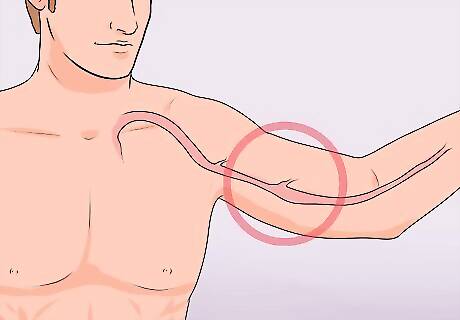
Apply indirect pressure if the bleeding doesn’t stop. In addition to direct pressure, apply indirect pressure between the bleeding site and the heart to limit the blood flow to the wound. This is done by putting pressure on arteries or, as they are sometimes called, pressure points, for a maximum of 10 minutes. They will feel like particularly large and hard veins. Applying pressure to them will constrict blood flow when direct pressure and elevation are ineffective. To slow blood flow to the arm, use 2 fingers to press on the brachial artery on the inner side of the arm, just below the armpit. For groin or thigh injuries, apply pressure to the femoral artery, between the groin and the upper thigh. This one is particularly large. You will have to use the entire heel of your hand to reduce circulation. For lower leg wounds, apply pressure to the popliteal artery, behind the knee.

Make a tourniquet. Tourniquets can stop deadly blood loss for several hours without causing harm. If the bleeding is extremely severe and you have a tourniquet on hand, use it. If you only have a bandage or fabric on hand, you can make a tourniquet. Wrap bandage tightly around the limb, between the wound and the heart, 5 to 7 centimeters above the wound. Wrap around limb several times and tie a knot. Leave enough fabric to tie a second knot around a stick. Twist stick until the bleeding stops. Write down the time the tourniquet was applied—leaving a tourniquet on too long can cause damage to the tissue, and a time-stamp can let caregivers know which patients to treat first.
Treating a Sucking Chest Wound
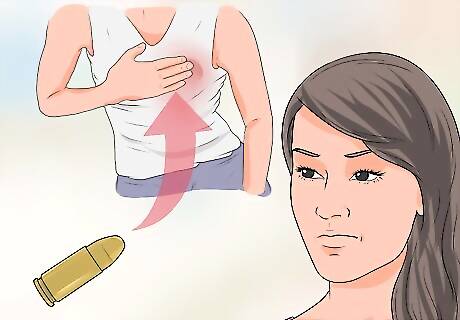
Recognize a sucking chest wound. If a bullet has penetrated the chest, it is possible that a sucking chest wound exists. Air is coming in through the wound, but not coming out, collapsing the lung. Signs of a sucking chest wound include a sucking sound emanating from the chest, coughing up blood, frothy blood coming from the wound, and shortness of breath. When in doubt, treat the wound as a sucking chest wound.

Find and expose the wound. Look for the wound. Remove clothes from wound. If some fabric is stuck to the wound, cut around it. Place a gloved hand or press a clean cloth over the wound. Determine if there is an exit wound and if so, apply procedure to the exit wound as well.

Seal the wound on three sides. Take a plastic wrap or bag or gauze pads covered in petroleum jelly and tape the dressing around the wound, covering 3 sides. As you seal the wound, encourage the patient to exhale forcefully 3 times while holding their breath. This will force all air out of the lungs. After they exhale, tape the fourth side of the dressing. If the patient has shortness of breath or labored breathing after the wound has been sealed, “burp” the wound by removing the seal and asking them to breathe out as if they’re blowing out the candles on a birthday cake. Reseal the wound.
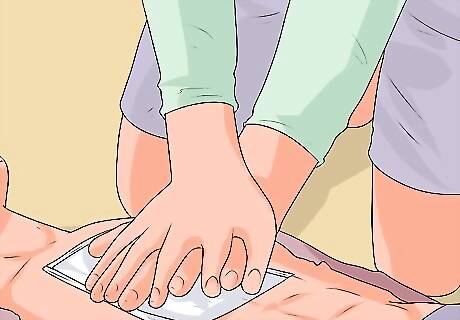
Apply direct pressure to both sides of the wound. It is possible to do this with two pads over each wound, held very tightly in place by a wrapped bandage.

Carefully monitor the patient's breathing. You can do this by talking to the conscious patient, or watching the chest rise and fall. If the patient stops breathing, reduce pressure on the wound to allow the chest to rise and fall. Prepare to perform CPR if their heart stops beating.

Do not release pressure or remove the seal when medical assistance arrives. They will either use your seal or replace it with a better one.

















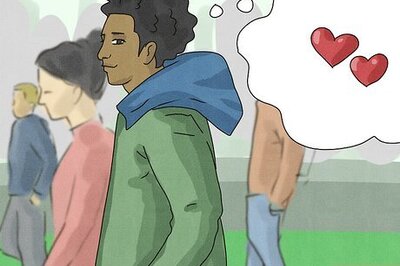


Comments
0 comment